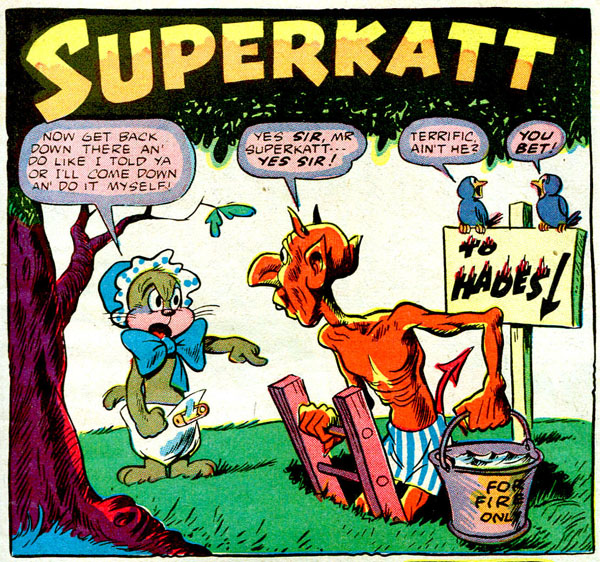
This week’s profile offers a detailed look into the career of an important figure in animation, Dan Gordon. With such a commonplace name as Dan Gordon, along with a death that preceded the critical appraisal of classic theatrical animation, the research involved proved to be a slight challenge. Hopefully, this will be the most in-depth overview on Dan Gordon’s career to date.
Daniel Campbell Gordon was born on July 13, 1902 to Irish parents John Joseph Gordon and Margaret Rauner Campbell in Pittston, Pennsylvania. By 1910, his family, along with his two brothers, relocated to New York in the Bronx where his father worked as a printer at a job office. By 1920, Gordon worked as a “draftsman,” presumably in an architectural environment, since the 1925 New York Census lists a similar occupation and shows him living with his brothers. By 1930, while his youngest brother George found work at Paul Terry’s animation studio in the Bronx, Dan Gordon continued as an architectural draftsman in New Jersey.
It is unclear when Gordon entered the animation business. It seems rational he switched to a different medium since the demand technical work, such as drafting, had diminished considerably during the height of the Depression. He started at the Van Beuren Corporation probably around 1933, either before or after the firing of John Foster, who had been head of the animation department. Gordon remained at the studio when Burt Gillett became supervisor in the spring of 1934. He drew model sheets for many of the Rainbow Parades, including the shorts based on Toonerville Trolley and A Waif’s Welcome (1936). Gordon advanced to a directorial credit at the studio shortly before it closed their animation division in 1936. Whereas Burt Gillett and Tom Palmer helmed many of the titles in the Rainbow Parade series, Gordon wrote and directed It’s A Greek Life (released in August) about a centaur cobbler repairing the winged shoes of the Greek god Mercury.
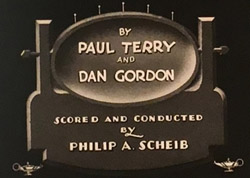
Gordon’s director credit on Terry’s “Pink Elephants” (1937)
His time at MGM was relatively brief, as Gordon moved to Miami at Max Fleischer’s new studio around 1938, where he was hired to rewrite the continuity for their first feature Gulliver’s Travels, along with Tedd Pierce and Cal Howard, both recruited from Warner Bros. While Gulliver was in production during 1939, Gordon worked as a story man on several theatrical shorts, which included a short-lived series of Stone Age cartoons, which depicted contemporary prehistoric life with an emphasis on its “modern” appliances and devices. He is also credited for the story on the two “historical” cartoons Popeye Meets William Tell (1940) and Popeye Meets Rip Van Winkle (1941).
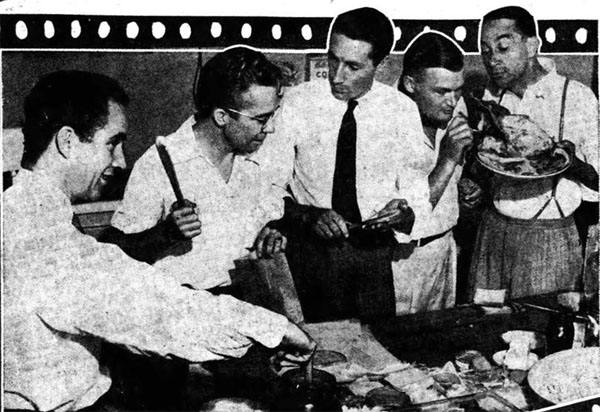
(left to right): Dan Gordon, Cal Howard, Tedd Pierce, Edmond Seward and Pinto Colvig in a staged photo at Fleischer’s Miami studio, April 1939.
The studio developed suggestions for a second feature during and after production on Gulliver. A film based on the tale of Pandora’s Box, derived from Greek mythology, was announced by April 1940, with Gordon slated as one of the principal directors, but the idea was discarded. Another proposal involved an adaptation of Maurice Maeterlinck’s The Life of the Bee, which details the human condition from a bee’s perspective. When the studio could not secure the rights to the Maeterlinck novel, they decided to devise an original story. The script for their new feature Mr. Bug Goes to Town was approved by the end of 1940, and was slated for a December 1941 release. Near the end of Mr. Bug, the large community of insects scramble along a skyscraper being erected, which owed to Max Fleischer’s mechanical inclination and Gordon’s architectural background. James Davis, an animator on Mr. Bug, recounted: “Dan could do it all, and do it better. His problem was that it all came so easy for him, if that’s a problem. We were always amazed at his skills.

Gordon’s “You’re A Sap Mr. Jap” (1942)
Besides two Superman cartoons credited to Gordon as “director” (Eleventh Hour and Jungle Drums), the black-and-white Popeye cartoons produced in Miami under his name displayed sharp comic staging and derisive humor reminiscent of the West Coast studios. The Hungry Goat (released June 1943) shows awareness between its characters and the audience, undoubtedly an influence from the Warners cartoons. Gordon had a predilection towards dark comedy such as “the bitter end” of Happy Birthdaze (released July 1943) when Popeye finally eliminates his pesky sailor friend Shorty. By mid-1943, Famous Studios had relocated to New York to be closer to Paramount’s headquarters. Later, Gordon supervised No Mutton fer Nuttin’ (released November 1943), the first film under the Noveltoons banner. The film marked the debut of Blackie the Lamb, a brash, wisecracking black sheep intended as a send-up of similar star characters prevalent in animated cartoons during the 1940s. However, Gordon was fired from Famous Studios shortly after the move to New York, due to his behavior related to alcohol and his name was omitted from the main titles.

Gordon’s “Superkatt” was adapted into a 1947 Screen Gems Phantasy cartoon
 Gordon soon expanded his work with human characters when he created high school student Cookie O’ Toole. Marking his debut in the April 1945 issue of Topsy-Turvy Comics, Cookie received his own series of magazines the following year. Unlike the Archie comics that typified the teen humor genre in comics, Gordon’s Cookie stories possessed a strong vitality with a satirical edge. By the end of the 1940s, while still drawing stories with Superkatt and Cookie, Gordon also worked with new characters. One such creation in Giggle, Bungle of the Jungle, revolved around a circus elephant that brings civilian recreation to the jungle animals, much to the chagrin of the human native Bozzin. Gordon also drew/inked two separate dog and cat pairs, Anthony and Cleopatra for Ha Ha and Puss an’ Boots for Funny Films—the latter duo’s were more frenetic and utilized more brutal slapstick. Another character used by Gordon in Funny Films was an eccentric rabbit inventor named Blunderbunny.
Gordon soon expanded his work with human characters when he created high school student Cookie O’ Toole. Marking his debut in the April 1945 issue of Topsy-Turvy Comics, Cookie received his own series of magazines the following year. Unlike the Archie comics that typified the teen humor genre in comics, Gordon’s Cookie stories possessed a strong vitality with a satirical edge. By the end of the 1940s, while still drawing stories with Superkatt and Cookie, Gordon also worked with new characters. One such creation in Giggle, Bungle of the Jungle, revolved around a circus elephant that brings civilian recreation to the jungle animals, much to the chagrin of the human native Bozzin. Gordon also drew/inked two separate dog and cat pairs, Anthony and Cleopatra for Ha Ha and Puss an’ Boots for Funny Films—the latter duo’s were more frenetic and utilized more brutal slapstick. Another character used by Gordon in Funny Films was an eccentric rabbit inventor named Blunderbunny.
While he maintained his profession as a comic book artist in late 1950, Gordon went to John Sutherland’s New York offices to work with agencies on developing television material. In a conversation with Milton Knight, the late publisher Fred Iger revealed that Gordon resigned from comics by the early 1950s—possibly around 1953—and moved to the Midwest for reasons unknown. However, it seemed Gordon was back in New York working in commercial studios a short time later. After a stint at Jack Zander’s Transfilm studio, he went back to work with Sutherland, negotiating with commercial clients in April 1954.
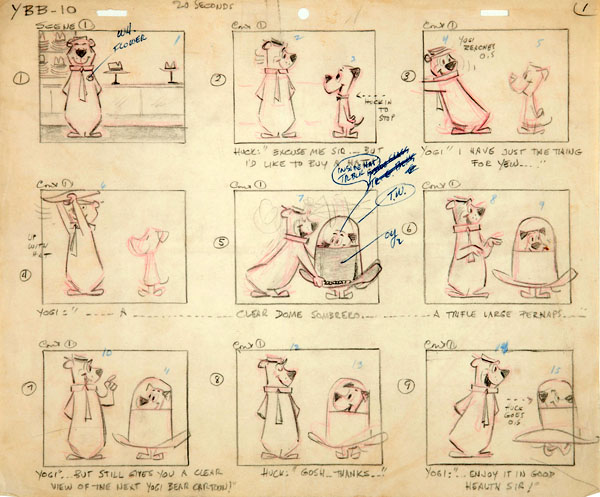
A Gordon board for a Yogi Bear interstitial
In 1957, Gordon was hired at Bill Hanna and Joe Barbera’s new television studio, as a story sketch artist on Ruff and Reddy. Besides drawing storyboards for programs such as The Huckleberry Hound Show and The Quick Draw McGraw Show, Gordon worked on early development for The Flintstones. Originally designated as “The Flagstones,” the show bore a resemblance to the Stone Age cartoons that Gordon worked on two decades earlier at Fleischer’s Miami studio. He drew the storyboards for the series’ first two episodes in production before the show aired on primetime in the fall of 1960, “The Swimming Pool” and “The Flintstone Flyer”. In January 1961, Dan Gordon left Hanna-Barbera to work at Quartet Films on television commercials as head of their story department.
Gordon returned to Hanna-Barbera, possibly around the time The Magilla Gorilla Show entered production in 1963. He continued as a story director on The Flintstones and Johnny Quest, as well as the studio’s first feature Hey There It’s Yogi Bear!. Over time, Gordon’s health deteriorated due to his severe alcoholism, which carried through for much of his career. According to Iwao Takamoto in an interview with Michael Mallory, he recalled one night at the Hollywood Roosevelt Cinegrill, which Gordon frequented: “I remember sitting with him one time and talking to him about something we needed scripted, and he communicated with drawings by this time, and his hands were constantly shaking. I remember wondering, ‘How the devil is he going to draw anything?’ And he picked up a pencil, and his hand was shaking like crazy, and as soon as the tip of the pencil touched the paper, everything just solidified. The hand quit shaking, and this little idea sketch comes out.”
Around the time The Atom Ant/Secret Squirrel Show went into production in 1965, Gordon left the studio indefinitely. It is unknown if Gordon pursued further into animation before his death on August 13th, 1970. According to the late Jack Mendelsohn, Gordon was killed in a house fire while in a drunken stupor. Some sources state his last known location was in Fulton County, Georgia. The circumstances of this locality are unknown, and verification based on death records is inaccessible.
Here is a sample of Gordon’s comic book work below, with an introduction by comics scholar/writer Frank Young:
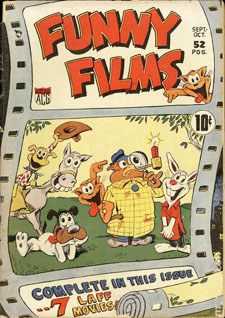 “Dan Gordon’s masterful cartooning and writing shine in the stories he wrote and drew for the Sangor agency. Like Robert McKimson, Gordon had a command of the contours of the human and animal figure. He often draws his characters with unusual body language and odd postures, and from POVs not often seen in the work of his peers. Gordon’s brushwork adds a vigor to his solidly-penciled and perfectly-posed characters. The drawings in his comic-book stories teem with life—motion, anxiety and surprise are aptly conveyed. Gordon’s work leaps off the page where his colleagues’ stuff often limps.
“Dan Gordon’s masterful cartooning and writing shine in the stories he wrote and drew for the Sangor agency. Like Robert McKimson, Gordon had a command of the contours of the human and animal figure. He often draws his characters with unusual body language and odd postures, and from POVs not often seen in the work of his peers. Gordon’s brushwork adds a vigor to his solidly-penciled and perfectly-posed characters. The drawings in his comic-book stories teem with life—motion, anxiety and surprise are aptly conveyed. Gordon’s work leaps off the page where his colleagues’ stuff often limps.
Gordon was a gifted comics writer. His “Cookie” and “Superkatt” stories have ingenious story angles, and his well-honed dialogue moves the reader at a furious pace through each episode. When Gordon was given room to stretch out—as in some “Cookie” stories that absorb 18 or 19 pages—he left many of his talented peers in the dust. Above all, Gordon’s stories are entertaining and coherent. They’re the standout feature of many humor comics of the post-war years. Gordon’s comic-book work remains one of the unexplored treasures of the 1940s and early ‘50s.”
• “Superkatt”—Giggle Comics #25 (January 1946)
• “Cookie”—Cookie #3 (October 1946)
• “Anthony and Cleopatra”—Ha Ha Comics #68 (October-November 1949)
• “Bungle of the Jungle”—Giggle Comics #71 (May-June 1950)
• “Blunderbunny”—Funny Films #6 (July-August 1950)
• “Puss an’ Boots”—Funny Films #28 (March-April 1954)
That wraps it up for this month! I will be back in June with animator breakdowns…

Pencils for a Dan Gordon Superkatt ACG cover
(Thanks to Yowp, Eric Costello, Milton Knight, Steve Stanchfield, Thad Komorowski and Michael Mallory for their help.)


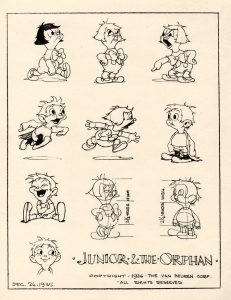

 DEVON BAXTER is a film restoration artist, video editor, and animation researcher/writer currently residing in Pennsylvania. He also hosts a
DEVON BAXTER is a film restoration artist, video editor, and animation researcher/writer currently residing in Pennsylvania. He also hosts a 





















































































Thanks for this profile, I knew bits and pieces about Gordon’s larger animation work, but this is a great chronology. I love Dan Gordon’s comic work for ACG, which is how I discovered him.
Fascinating stuff, as usual. I remember “A WAIF’S WELCOME” quite well, along with many of the CAPTAIN AND THE KIDS cartoons. While the latter’s otherwise lavish MGM sepiatoned series was not the most popular, it has its moments, and I wonder exactly which cartoons Dan Gordon did drafts on. Bill Hanna and Joe Barbera must have liked his work,m because he worked with them at MGM and eventually went on to do work for them on TV cartoons, and all the work mentioned here is of very high quality. George Gordon, his younger brother had worked on some of the BARNEY BEAR cartoons, some of the best in the series as I can recall from past filmographies, like “BEAR-RAID WARDEN” and “BARNEY BEAR’S POLAR PEST”, and those first two “FLINTSTONES” half-hours were amazing.
George had also worked on a few other MGM cartoons..such one with that mule/donkey andf one with a stork, among a few others.
Would have been interesting to see what would have happened at Famous if Gordon had stayed on, since his efforts were more open to the West Coast style of timing and pacing (and he allowed his head animators, like Tyer, free reign of expression). You can see the cartoons starting to tighten up and slow down their pacing pretty quickly after the move back to NYC, though things didn’t really get bad until the end of the decade.
That pencil art isn’t SUPERKATT. It’s PUSS AN’ BOOTS.
DG was born damn near Biden Country™.
This was a nice profile on Dan Gordon, Devon. When I was in high school, I was in an out of Jam Handy. I heard about Dan Gordon through Bob Kennedy, the Department Supervisor. So it is reasonable to assume that Gordon had done some work for them since Handy’s was near the Wayne State and The Society of Arts and Crafts.. I knew that he taught for a while through Bob Vigillnetti, the instructor of photography. He seemed in awe Dan. But there was never any mention of his drinking. It isn’t surprising though since a lot of the old time Animators were drinkers, Shamus Culhane being one of them.
I’d be interested in the source that verified that Dan Gordon was associated with the Manhattan model used for the opening title sequence for MR. BUG GOES TO TOWN. My sources indicated that Robert Little, who also had a background in architecture designed it. But that’s always the challenge in finding the facts about things that happened before we were born, made all the more difficult since the parties involved have long passed away.
Great article on Dan Gordon,I have several original storyboards by him. Hey Devon have you done the article on the animator we talked about? I have lots of information and original drawings by him.lf you still want me to help you? Let me know.
Hey James, I’d love to check out those original drawings if you ever have a free moment!
Hi Donal, I’m Cathy Kienlen Janson, Rosemary Gordon Kienlen’s daughter. Rosemary was Dan Gordon’s sister, almost 15 years younger than Dan. If you are Dan’s grandson, we met at the wedding of Kate Gordon, Frank Gordon’s daughter, in 1979. If this is you, I’d love to hear from you. Meg Westfall, Frank’s daughter, alerted me to this website.
I’m married to the grandson of Dan Gordon. My husband was born in 1969 so didn’t know his grandfather well. My husband was born in Fulton County Georgia in 1969 so it would make sense that Dan Gordon would have been there at the time and died of liver failure. However, he states that Dan Gordon’s son died in a fire in California. This son may have some credits for cartooning briefly.
My grandfather, William Sylvester Gordon, was John J. Gordon’s brother, and uncle to career cartoonists Daniel Campbell and George Francis Gordon. My father, John Edward Gordon (1919-2010) as a youth remembered his cousins. I continue to research our family genealogy and would be pleased to get in touch with this branch of the family.
I see Dan Gordon’s name as story director on many episodes of the original Jonny Quest in 1964. What did a story director do on Quest back then at Hanna-Barbera? Did he direct the actors when recording the scripts? Quest had some incredibly solid audio performances for so much of it’s single season run. In Tim Matheson’s book he made it sound like Joe Barbera did most of the “actor directing” on Quest so I am asking if anyone has knowledge of how the Quest shows were directed and recorded. Was Dan Gordon the Andrea Romano of Hanna-Barbera back then? Can anyone shed some light on the process of how these wonderful Quest episodes were performed? Would love to have an idea. Many thanks.
Dan Gordon did not die in a house fire. His son, Michael, also an animator, died in a house fire from falling asleep with a lit cigarette. His other son, Kevin, also died young in a car accident. These tragedies and Dan’s unhealthy lifestyle may have led to his stroke in the late 60s, which Hanna and Barbera used to end his tenure, even though he was still capable of working.
Hanna and Barbera paid Dan a final check and rejected his pleas to continue working. Dan returned to his remaining son’s (Donal) house in Atlanta, Georgia, and lived out his final days in the spare bedroom. Supposedly his room was cluttered with doodles and drawings scribbled onto anything that could hold ink…napkins, receipts, etc.
He died alone, broke, at Grady Hospital in Atlanta. I don’t know where the rest of the family was, but my father (Dan’s grandson) remembers the call from the hospital while attending college.
For whatever reason, Dan Gordon was not returned to the family plot in New York, but buried alone, in an unmarked grave in Arlington memorial park in Sandy Springs, GA. My father’s family was also suffering from financial and alcohol problems, so likely they couldn’t afford the gravestone.
I have archival documentation to corroborate the story, as Dan Gordon is my great-grandfather.